***************************************************
UPDATED MARCH 1, 2008 - SAT. 8:30 am Central Time
Fires blaze in Ashkelon’s shopping center from direct rocket hit Saturday as Gaza war intensifies
March 1, 2008, 5:16 PM (GMT+02:00)
Chaos In Gaza
45 Palestinians Killed Following Israeli Raid
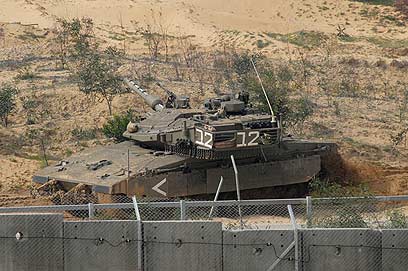
IDF tank in Gaza, Friday (Photo: Amir Cohen)
Gaza war intensifies Saturday. Five Israeli soldiers wounded, 2 seriously, 32 Palestinians killed. Israel aims to stop missile attacks by destroying Hamas rule
March 1, 2008, 1:55 PM (GMT+02:00)

Ashkelon woman wounded by Palestinian rocket
DEBKAfile’s military sources report that after 21 missiles slammed into Ashkelon and Sderot and their environs overnight, Israeli Givati Brigade troops backed by tanks, F-16 fighters and helicopters went after terrorist targets in Sejaya and Jebalya, N. Gaza Strip early morning Saturday, March 1. Five Israeli soldiers were injured, two very seriously. The Palestinians report 32 dead and dozens of injured casualties.
Two waves of Grad rockets hit the Israeli town of Ashkelon for the third day running. Two crashed into a house, injuring 5 people, two of them children. There were dozens of shock victims. Another 11 Qassam missiles explode at Sderot early Saturday - 33 in all.
Our military sources report the Israeli military command is now targeting Hamas rule of the Gaza Strip as ultimately the only effective way of halting the Palestinian missile offensive against civilian locations. It therefore proposes to systematically destroy Hamas institutions one by one until its rule of Gaza caves in.
This tactic was presented to prime minister Ehud Olmert Friday on his return from Japan. If Hamas alternatively decides it can no longer afford the exorbitant price exacted by the Israeli military for sustaining its missile offensive, so much the better. Meanwhile, the port town of Ashdod north of Ashkelon and 27 km from Gaza is preparing for start of Palestinian rockets attacks. Twelve alert systems are ready.
The IDF has set itself the following targets:
Every Palestinian military and security installation belonging to Hamas, as well as its Al Dawa social welfare branches used as meeting places and the money changers’ places of business.
A series of ground operations on the same lines as the Sejayia raid will be launched to drive Hamas and its allied terrorist groups out of northern Gaza – the sites of most missile launches against Ashkelon and Sderot. Once this part of the territory is purged, Israeli military control can be exercised without reoccupation.
DEBKAfile’s Palestinian sources report that Hamas leaders are well aware of the IDF’s revamped tactics and have employed counter-measures.
1. Their heads of government, armed wings and clerical authorities have gone to ground.
2. Their rank and file have taken over an estimated 3,000 to 4,000 civilian homes around Gaza City active and set up a wall for the town’s defense. Each home is provisioned with sufficient ammo, water and food for three weeks’ combat.
3. All Hamas operatives have dumped their cell phones and all means of communication which could betray their whereabouts. Orders and messages are carried by courier, usually children.
4. Thousands of missiles and rockets of different types are stocked in private homes and schools inside Gaza City and its refugee camps to escape Israeli attacks. This stratagem allows Hamas to calibrate its missile barrages on Israeli civilians according to the intensity of Israeli strikes against them.
*************************************************************************************
.38 Special Expansion Tests (Water)
By
Aaron Brudenell & Stephen A. Camp
Most agree that 10% ballistic gelatin is the gold standard for bullet performance testing. It replicates human tissue and its 10% formulation is generally accredited to Dr. Martin Fackler, who did ballistic wound research for the US military. People on all sides of the "stopping power" issue use calibrated gelatin at a specific temperature for determining a cartridge's expansion and penetration characteristics. Following their protocol, test results from one individual or group can be duplicated elsewhere by others.
I personally believe that it is probably the best general indicator of what a bullet can be expected to do, but I emphatically do not trust it to be as accurate in penetration expectations as some appear to. If we are shooting pig muscle, which replicates human tissue closely and is what ballistic gelatin's properties are based upon, it should be very close. In other words, if a bullet expands to X-diameter and penetrates Y-distance in 10% ballistic gelatin, we should get approximately the same results in pig or human muscle. The problem is that I don't intend to shoot either animals in the field or human felons in the arms or legs and I'll bet most don't either!
Some opine that where a bullet strikes in the torso really won't make much difference in the handgun bullet's penetration or expansion results. This has emphatically not been my observation on animals in the field that were shot with most of the popular calibers used for self-protection. Bullets that hit bone have reacted very differently from those that passed through shoulders and lungs or a semi-liquid-filled stomach.
Penetration depths have frequently been similar to what occurred when shot into 10% ballistic gelatin, but in my experience there have also been fairly frequent variations. So while it is the most widely accepted testing media, it is not infallible. Still, it does provide interesting results that measured, photographed, and studied by serious students of terminal ballistics.
In any test media we are really comparing the expansion/penetration characteristics of one bullet to another in that medium. If an appropriate substance is used, it might be inferred that similar results could be expected in the "soft targets" that the media is hoped to replicate.
Ballistic gelatin may be the bullet expansion test media of choice, but it is not without problems. It is relatively expensive for the average fellow and it must be used within a narrow temperature range for valid results. Few of us laymen have either the cash or the facilities to do this.
Rather than shying away from "backyard ballistic testing" as "unqualified", some opt to take a look at bullet performance in a medium that is readily available and can be used at all temperatures above its freezing point and below its boiling point: water.
This medium is not without problems. Because it is more fluid than gelatin it tends to cause jacket separation from the lead bullet core in hollow points to an exaggerated degree when compared to either tissue or gelatin and getting precise penetration depths is more difficult. If penetration depths can be accurately measured, penetration depths in ballistic gelatin can be interpolated. Expansion testing in water is often not uniform amongst shooters. Some use plastic jugs while others go with cardboard milk cartons or simply a large container of water.
Does that mean that it cannot be used to learn anything about what we might expect from an expanding bullet? I think not. Results will not be accepted as "valid" by any of the serious researchers, but it has been my observation that bullets fired into water can match actual "soft target" results fairly closely.
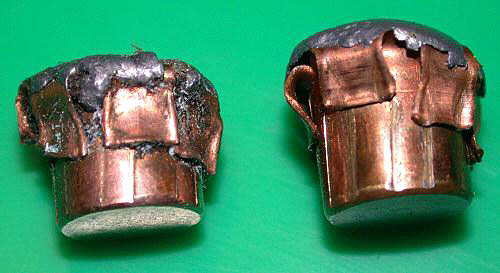
These are not .38 Special bullets. They are 9mm 124-gr. Hornady XTP's that I handloaded for use in my 9mm pistols. Each was fired using the same weight charge of powder and from a Browning Hi Power. The one on the left was recovered from a javelina. The one on the right was fired into water. The expanded bullets are fairly close in appearance although the one shot into the denser animal expanded a bit more.
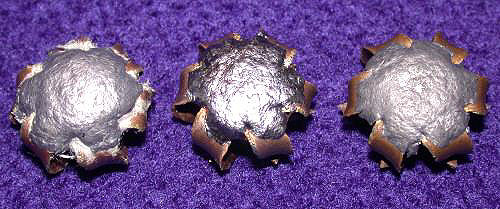
These three 9mm bullets were all fired from a Browning Hi Power. They are Winchester 127-gr. +P+ JHP's fired into different test media. The one on the left was fired into "wet pack" which is simply supersaturated newsprint. The one in the middle was used to cleanly kill a Texas whitetail deer. The one on the right was recovered from water. Are they different? Yes, but in this case they appear more similar than different. I have seen enough similarity to "trust" water expansion testing as a fairly decent indicator of what might be expected in real life. Is it as good as gelatin? Nope! I cannot get predicted wound channel depth and diameter at all nor expected penetration as easily.

These 230-gr. .45 ACP bullets were fired over the same weight charge of powder from the same 5" bbl 1911 pistol into water. Impact velocities are more in line with what we can expect from the .38 Special. The bullet on the left is a Remington Golden Saber. The one on the right is a Hornady XTP. Note that both are beginning to slip their jackets. In real life this is reported to happen more with the Golden Saber than the XTP. I have seen it occur with the Golden Saber in a deer, but as is often the case in gelatin testing, this usually occurs in the last couple or three inches of penetration. For those interested, the results of using a 230-gr. Golden Saber on a deer can be found here:
http://www.hipowersandhandguns.com/45%20ACP%20Golden%20Saber%20Field%20Report.htm
(I think you will note some real differences in what happened in a non-homogeneous animal and ballistic gelatin (or water) that is of the same density throughout and without bones.)
With all of this in mind, let's take a look at a few .38 Special bullets that were fired into water and see how they perform from different barrel lengths.
Mr. Aaron Brudenell was kind enough to send me several expanded bullets that were fired into a large container of water without passing through any barriers. This was done several years ago and he didn't remember the exact revolver makes used for each barrel length. This is not important in the general approach of this article for not every reader will be using exactly the same .38 Special revolver. If the expanded bullet shown is from a 2" barrel, the reader using a 1 7/8" J-frame can still expect the results to be meaningful to him as can the shooter with a 2 1/2" Model 19. No two revolvers, even the same make an barrel length, will always give the same velocity even with the same load fired from the same box of ammunition. The only way that I've found to know the actual velocities of my handguns has been to chronograph them. Because there will probably be slight…or not so slight velocity variations between the same make/model handguns, I will refer to expected velocity ranges rather than a specific speed.
Let's take a look at three .38 Special loads that are currently available.
Remington 125-gr. Golden Saber +P: This JHP differs from the traditional in that the jacket is not of the usual gilding metal common to most handgun bullets. It is made of brass and expands wider than the lead core. These have proven to be pretty reliable expanders in the calibers I've used to shoot various test media including two deer. (The deer were cleanly killed and were eaten.) Remington offers the Golden Saber in most popular calibers including .380 ACP, 9mm, .38 Special, .357 Magnum, .40 S&W, and .45 ACP.
This bullet is said to have a muzzle velocity of 975 ft/sec, but that's for a four-inch barrel. I have found that in the 1 7/8 to 2 1/4" snubs, velocities are around 900 ft/sec.
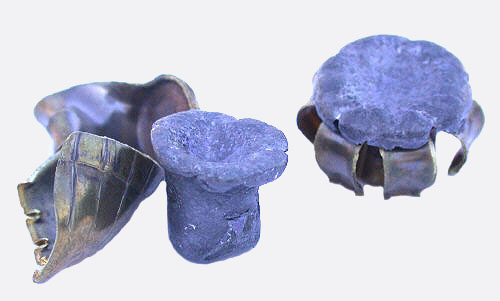
The .38 Special Remington Golden Saber shown in the foreground shed its jacket when fired into water from a 2" bbl. The lead core expanded to .470"at its widest point and the recovered jacket and bullet weighed 124.5 grains. The expanded Golden Saber on the right was fired from a 4" bbl and expanded to 0.606". Though the petals are folded back in the photograph, at some time during penetration of the media the diameter was larger. It weighed 124.6 grains.
Speer 125-gr. Gold Dot +P: Listed muzzle velocity is 945 ft/sec, but again, this doesn't mean that every 4" bbl will provide this exact speed. From a snub expect speeds under 900 ft/sec in most cases.
The Speer Gold Dot is a well-respected bullet generally held in pretty high esteem among shooters. The jacket is more malleable (higher copper content) than the traditional gilding metal and it is bonded to the lead core so that separation is less likely. In the pictures below we do see some separation and slight fragmentation. Keep in mind that these were shot a good while back and that Speer has continued to "tweak" the Gold Dot for superior performance. Of the three .38 Special loads tried, in this instance the Speer showed the greatest variation in both recovered diameters and bullet weights, but these differences are more visual than what the numbers actually show. Remember also that water has a greater tendency to separate jackets from bullets than either tissue or gelatin.

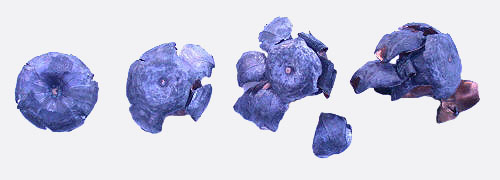
Here we see the Speer 125-gr. +P .38 Special bullet as fired from different barrel lengths into water. The row of expanded bullets on the top row provides a side profile and the bottom row provides one from the front. From left to right, these bullets were fired from 2, 4, 6, and 8" barrels. The listed velocity of 945 ft/sec is probably most accurate for the one fired from the 4" tube. The 2" speeds will be below and the longer barrels are probably above it. How significant an increase is present depends on the powder being used by the company. From the 2" barrel, the 125-gr. Gold Dot expanded to 0.544" and the recovered bullet weighed 124.2 grains while the 4" yielded 0.673" and 117.4 grains. The 6" tube resulted in a recovered bullet and fragment that weighed 124.1 grains and expanded to 0.742" at the widest point.
Not resting on past accomplishments, Speer recently introduced a .38 Special +P cartridge specifically intended for use in snub revolvers. It weighs 135 grains and those who have already tested it report very encouraging results. I have not yet tried this load or it would be included in this report.
Remington and Winchester 158-gr. LSWCHP +P: Definitely "old technology", these unjacketed lead semi-wadcutter hollow points remain a popular choice for many snub gun carriers including me. This load, whether from Remington, Federal, or Winchester, has been dubbed "The Chicago Load" or the "FBI Load" and more than a few revolver-toting police officers have carried it.
I have had good luck with it and for now, the Remington remains my carry load of choice. I think you'll see why in the picture below.
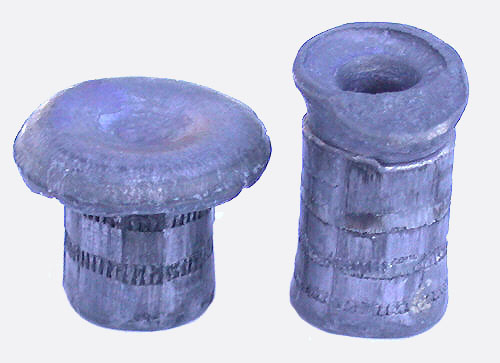
These two 158-gr. LSWCHP +P bullets were both fired from the same 2" revolver. The one on the left is from Remington. The other is from Winchester. The Remington expanded to 0.629" and weighed 156.9 grains. The Winchester expanded to 0.394" and weighed 156.8 grains. What caused the difference in performance? From snubs, both travel around the 800-ft/sec mark. The difference is that the Winchester bullet has higher antimony content. It is not as "soft" as pure lead. It appears that while these two respected ammo makers provide a very similar load, there is a difference if using a snub revolver.
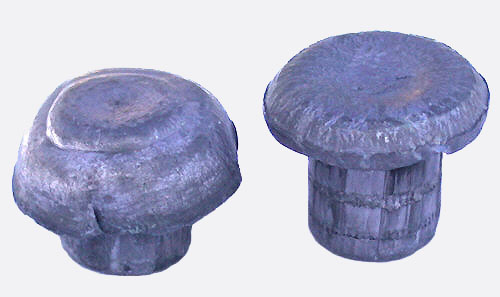
Here are the same two makers' bullets fired from a 4" revolver. The Remington (left) expanded to 0.647" and weighed 156.6 grains. The Winchester (right) expanded to 0.593" and weighed 156.6 grains, as did its competition from Remington.
The main complaint about this style bullet when fired from a snub seems to be that it routinely fails to expand after passing through the standard 4-layers of denim before entering the 10% ballistic gelatin. For this reason some do not recommend this load. It also has pretty sharp felt recoil in the lightweight snubs and cannot be used at all in the super-light titanium revolvers being offered as the non-jacketed bullet will unseat itself in recoil. (They are fine for use in the aluminum frame snubs such as the S&W Model 637 or super popular 642 and their blue counterparts.) Instead a recommendation for the 148-gr. target full wadcutter is made. I disagree with this unless felt recoil is a major problem for the individual shooter. The velocities are just too low for me to be comfortable with. I've clocked several wadcutter loads from different makers at velocities below 600 ft/sec with some being just over 500 ft/sec from S&W J-frame snubs.
I have not done nearly so much testing with the .38 Special as I have other calibers and don't have as much first-hand data to offer. I have seen one previously wounded deer finished off with a Remington 158-gr. LSWCHP +P. It was struck in the chest under the neck and the expanded bullet was recovered just before passing through the stomach. This was before the digital camera but the bullet closely resembled the expanded ones shown previously. Two law enforcement officers I've spoken with used their "Chicago Loads" to end felonious deadly force scenarios successfully. Each officer was using a snub and a single shot to the chest in each situation settled the matter with the elusive "one shot stop."
Right now, were I looking for an effective .38 Special load for my snub, I'd take a hard look at the Remington 158-gr. LSWCHP +P, the new Speer 135-gr. Gold Dot +P, and Corbon's 110-gr. DPX +P. For those interested, I do have a test report on their now discontinued standard pressure version of the DPX. I have some of the .38 +P DPX but have not yet tested it. Here is the link:
http://www.hipowersandhandguns.com/Corbon%2038%20Special%20Ammo.htm
www.truthaboutparts.blogspot.com
www.tjofsugarland.blogspot.com
www.handgunpartsforsale.blogspot.com
www.hipowersandhandguns.comhttp://www.spw-duf.info/links.html#guns
*****************************************
US warships move into E. Mediterranean in case Gaza escalation spills over into Lebanon
February 29, 2008, 1:30 PM (GMT+02:00)

Egyptian Gen. Suleiman cancels Israel visit
Friday, Feb. 29, Egypt’s intelligence minister Omar Suleiman canceled his visit to Israel because of estimates in Cairo that hectic preparations current in Israel and the Gaza Strip augur a steep escalation of cross-border violence.
DEBKAfile’s military sources report: Officials in Cairo expect Israel redouble its air bombardment and armored raids against Hamas targets in the Gaza Strip, and Hamas to intensify and broaden the scope of its missile and rocket attacks on Israeli towns and villages.
Both sides are convinced that a further ratcheting-up of the war will generate indirect truce talks through a third party.
The US has meanwhile posted naval and marine vessels opposite the shores of Israel and Lebanon in case the fighting spreads to a second front. DEBKAfile’s Washington sources quote US and Israeli military sources as skeptical of the chances that prime minister Ehud Olmert and defense minister Ehud Barak will secure a ceasefire. The Gaza conflagration is more likely, they believe, to stir Hizballah to ignite a fresh assault from South Lebanon.
These sources point to four significant developments to watch for:
1. Hizballah is adamant about avenging the death of its military commander Imad Mughniyeh by border strikes against Israel and terrorist attacks inside the country. This Iranian front group is also committed to helping Hamas. The end of the 40 days of mourning for Mughniyeh on March 22-23 is anxiously awaited.
2. Israel is braced for this eventuality and in mid-preparation for its army to turn the tables on a Hizballah assault and carry the war into Lebanon.
US intelligence sources note that last week, the IDF deployed Patriot missile defense batteries around Haifa in case Hizballah unleashes a rocket offensive on the North as in 2005.
Our sources also report that local authorities and private security firms responsible for public safety in northern Israel were instructed to inspect bomb shelters and ascertain they were ready for use by March 10.
3. The quarrel between Saudi King Abdullah and Syrian president Bashar Assad, which is nearing boiling point, threatens to be fought out in Lebanon, their main bone of contention. Both are sending quantities of arms and ammo to the Lebanese militias under their respective wings.
4. This week, Abdullah persuaded Egyptian president Hosni Mubarak and Jordan’s Abdullah to boycott the forthcoming Arab League summit in Damascus. Assad is unlikely to take this slap in the face lying down. There are indications he is ready to stir up Palestinian terrorist groups for attacks on Saudi, American and Israeli interests in the region.
Standing close by for immediate action off the troubled Mediterranean shores of Lebanon, Israel and Gaza is the USS Cole guided missile destroyer opposite Lebanon. It was joined Monday by the USS Nassau amphibious warship and its strike group of six vessels carrying 2,800 marines, flight crews and sailors. US naval sources report that a third group will join them shortly.
DEBKAfile’s military sources report the Nassau is accompanied by the amphibious transport dock ship USS Nashville , the guided missile destroyers USS Ross and USS Bulkeley and the fast nuclear strike submarine USS Albany SSN 753.
While cruising off the Lebanese coast, this formidable US naval force is close enough to the shores of Israel and Gaza to respond to developing emergencies.
FROM ARIZONA
01:42 PM Mountain Standard Time on Friday, February 29, 2008
 3TV PHOTOS: Seized weapons
3TV PHOTOS: Seized weaponsGILBERT -- High-powered rifles and semi-automatic weapons were part of the hundreds of weapons seized after the ATF served a search warrant at Cavalry Arms, a licensed gun manufacturer in Gilbert.
Authorities have only said that Cavalry Arms is accused of violating federal firearms laws. Reports reveal that Cavalry Arms does most of its business online, and neighbors in the area claim seeing little traffic in or out of the business. But neighbors also said they were surprised by the actions, and described Cavalry Arms as a 'heads-up' business that didn't draw any suspicion in their opinion.
The ATF did not go into any details as to exactly what firearms laws had been broken, only that they were processing and seizing all of the weapons at the Gilbert gun manufacturer.
The ATF directed future inquiries to the US Attorney's office, whom said they wouldn't comment on an on-going investigation.
PREVIOUS REPORT:
The A.T.F. has seized hundreds of weapons after serving a search warrant at a Gilbert gun store. Right now it is not known why the ATF served the search warrant or why the guns were seized.
******************************************************************************************

East Texas Bird Dawgs







